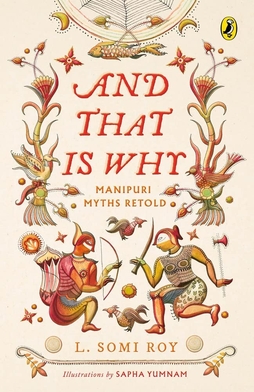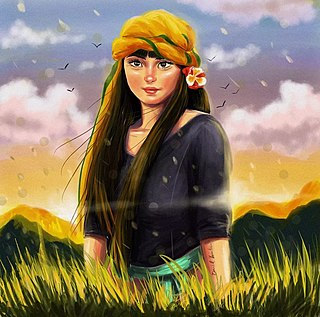
Imoinu or Emoinu is a goddess associated with household, hearth, family, fireplace, kitchen, wealth, peace and prosperity in Meitei mythology and religion of Ancient Kangleipak. She is frequently associated with Leimarel Sidabi. She is regarded as one of the incarnations or representations of goddess Leimarel Sidabi.

Nongshaba is a lion god in Sanamahism and Meitei mythology. He is also regarded as a king of the gods. He is credited with producing light in the primordial universe and is regarded as the maker of the sun. He is worshipped by the people of both the Ningthouja clans as well as the Moirang clans. Nongshaba was worshipped by the people of Moirang clan as a lineage deity and regarded as the father of the god Thangching. He is the greatest of the Umang Lais but he made his only son Thangching the chief deity of Moirang.

Irai Leima is a goddess in Sanamahism, the indigenous religion of Manipur. She is the goddess and the divine female personification of water and aquatic life. She is the consort of Irai Ningthou. Both are regarded as the divine spirits of water bodies. She is also considered to be in charge of diseases.

Phouoibi Shayon, also simply known as Phouoibi, is a 2017 Indian Meitei language mythological film, about goddess Phouoibi and other celestial fairies who came down to earth to prosper the human civilization. The film is directed by O. Samananda, starring Lilabati, Kaiku Rajkumar and Gokul Athokpam, under the collaboration of Kanglei Movies World and Sergey Film Production.

Phou-oibi, the Rice Goddess is a 2013 Meitei language ballad opera, based on the story of goddess Phouoibi, adapted from Meitei mythology and folklore, performed by the Laihui Ensemble from Manipur, India, as a part of the "Tapestry of Sacred Music 2013" programme, held at the Esplanade in Singapore.

Phouoibi or Phouleima is the goddess and the female personification of the agriculture, crops, fertility, grains, harvest, paddy, rice and wealth in Meitei mythology and religion of Ancient Kangleipak . She is the lover of Akongjamba, a hero in ancient legends. But fate does not permit the lovers to unite. So, Phouoibi and Akongjamba reincarnated in the legends. She was sent by Thangching to Moirang) kingdom to make the human world prosperous. The legends of her love with Akongjamba were believed to be enacted by Thangching as a part of the Moirang Saiyon legends.

Noinu Thumleima or Thumkhong Lairembi is the Meitei goddess of salt.
Akongjamba was a nobleman in Ancient Moirang in Meitei mythology. He was a lover of the harvest Goddess Phouoibi. According to mythology, fate did not permit the lovers to unite, so they reincarnated. The lives of the two legendary lovers were believed to be enacted by Thangjing as a part of the epic cycles of incarnations.

Phou Ningthou is a deity in Sanamahism, the indigenous religion of Manipur). He is the God and the divine male personification of the agriculture, crops, fertility, grains, harvesting, rice paddies, rice and wealth. He is the consort of Phouoibi (Phouleima), the goddess of crops and agricultural fertility.

Shapi Leima or Sapi Leima is the goddess of rodents in Meitei mythology and religion. She is a sister of goddesses Khunu Leima and Nganu Leima. Legend says that all three sisters married the same mortal man.

And That Is Why... Manipuri Myths Retold is a children's book based on 12 stories from the Meitei mythology of Manipur, written by L. Somi Roy and published by Penguin Random House India. It was launched by Member of Parliament Rajya Sabha and titular King of Manipur Leishemba Sanajaoba at the palace compound, Imphal on 21 June 2021. The stories are adaptations of tales found in the puyas.

Kao is a legendary divine bull captured by Khuman Khamba in Meitei mythology and folklore of ancient Moirang realm. It appears in the legend of Kao Phaba, also known as Khambana Kao Phaba of the Khamba Thoibi epic.

In Meitei mythology and folklore, the epic cycles of incarnations in Moirang is a cyclic epic of seven incarnations of two divine lovers in the kingdom of Moirang in the realm of Ancient Kangleipak.

The ancient legend of Ura Naha Khongjomba and Pidonnu is an epic cycle of incarnations of Meitei mythology and folklore from the Moirang kingdom of Ancient Kangleipak. It concerns the love and adventures of the forgotten prince Ura Naha Khongjomba for the beautiful woman Pidonnu.

The ancient legend of Wanglen Pungdingheiba and Sappa Chanu Silheibi is one of the tales of incarnations described in the Moirang Shayon. Moirang was an independent kingdom, but later became a province of Manipur. It concerns the tragi-comic romantic adventures of Wanglen Pungdingheiba for his ladylove Sappa Chanu Silheibi). Wanglen Pungdingheiba was a skilled craftsman known for making musical instrument pung. Lady Sappa Chanu Silheibi was a skilful weaving artisan. Both the lovers are equally noted for their talents and good looks, thereby becoming the matters of envy of many young men and women in the kingdom of Moirang.

Keibu Keioiba, also known as Kabui Keioiba, is a 2009 Meitei language Indian Manipuri animation feature film, directed by Bhumenjoy Konsam. It is the first Manipuri animation film, based on the Meitei folklore. It was screened in the 11th Mumbai International Film Festival (MIFF) in 2010, under the aegis of the Ministry of Information and Broadcasting.

The ancient legend of Khamba and Thoibi is a classic, as well as one of the epic cycles of incarnations of Meitei mythology and folklore, that is originated from Ancient Moirang kingdom of Ancient Kangleipak . It is referred to as the "national romantic legend of Manipur" by Indian scholar Suniti Kumar Chatterjee.

The Laihui Ensemble is a centre for research on traditional and indigenous performing arts, based on Imphal, Manipur. It was established in 1985. The association is performing different art shows at different venues across different nations in the world. Mangka Mayanglambam is one of the most active artists of the ensemble, and is trying her best to revive the dying art forms of Manipur including the Moirang Sai.

Women have significant roles in different elements of Meitei culture, including Meitei dances, Meitei festivals, Meitei folklore, Meitei folktales, Meitei literature, Meitei mythology, Meitei religion, etc.













